Matt’s Off-Road Recovery Kinetic Recovery Rope (Yankum Ropes), Bubba Rope, Smittybilt, Rhino USA, FieryRed, Inclake, and Sgt Knots. Ropes tested for elasticity under load. Ropes then experienced 25 pulls to test durability. Following the 25 pulls, the ropes were tested again for the loss of elasticity and “permanent rope stretch.”
Table of Contents
- Best Kinetic Recovery Rope: Top 7 Picks
- 1 – Bubba Rope Kinetic Recovery Rope (Best Buy)
- 2 – Yankum Ropes Kinetic Recovery Straps
- 3 – FieryRed Heavy Duty Kinetic Recovery Rope
- 4 – INCLAKE Kinetic Recovery Rope
- 5 – Rhino USA Kinetic Recovery Rope
- 6 – SGT KNOTS Double Braided Kinetic Recovery Rope
- 7 – SMITTYBUILT RECOIL Kinetic Recovery Rope
- 1. What is a kinetic recovery rope?
- 2. How do I choose the suitable kinetic recovery rope?
- 3. How do I properly use a kinetic recovery rope?
- 4. Can a kinetic recovery rope damage my vehicle?
- 5. Can a kinetic recovery rope be used for towing?
- 6. How do I store a kinetic recovery rope?
- 7. Can a kinetic recovery rope be used in all weather conditions?
- 8. Can a kinetic recovery rope be used for off-road recoveries?
- 9. Can a kinetic recovery rope tow boats or trailers?
- 10. Can a kinetic recovery rope be used for recovery on pavement or concrete?
- Why You Need a Kinetic Recovery Rope
- Best Kinetic Recovery Rope FAQs
- FAQs
- 1. What is the weight rating of a kinetic recovery rope?
- 2. Can I use a kinetic recovery rope for towing a trailer?
- 3. How often should I inspect my kinetic recovery rope for damage?
- 4. Can I use a kinetic recovery rope for recovering a vehicle on the pavement?
- 5. Can I use a kinetic recovery rope to recover a water vehicle?
- 6. Can I use a kinetic recovery rope for recovering a vehicle on a steep incline?
- 7. Can I use a kinetic recovery rope for recovering a vehicle in extreme weather conditions?
I derive immense pleasure from observing Matt and his skilled team’s impressive off-road recovery endeavors. Their ability to efficiently liberate vehicles from predicaments is genuinely commendable. However, a thought lingers: are they utilizing the most optimal path to recovery? In our quest for knowledge, we embark on an initial experiment to determine the kinetic energy rope with the most substantial stretch. Following this, we conduct a series of 25 rope pulls, scrutinizing their stretching capabilities extensively. A captivating challenge presents itself as Cousin Eddie finds his unique farmabago ensnared in a perplexing situation involving a pond and bagels. We eagerly anticipate witnessing the prowess of the robust ropes in extricating this intriguing predicament. Lastly, our exploration delves deeper as we undertake the dissection of a rope, seeking insights into its intricate construction.
Let us begin by delving into the least expensive recovery rope under our scrutiny, priced at a mere fifty dollars. This remarkable creation hails from the esteemed manufacturer, Sergeant Knots. It proudly boasts an impressive tensile force capacity of up to 30,000 pounds. The central focus of this rope is the mitigation of abrupt jerks and stress on both participating vehicles. Its toughness outshines traditional nylon straps by two to three, surpassing steel cables’ resilience. Of notable origin, this rope is crafted in China and weighs just over eight pounds.
Our exploration proceeds by establishing a baseline performance level through a meticulous chain test. With a keen eye, Cousin Eddie oversees this initial experiment from atop the farmabago. Our endeavor commences with evaluating the Suburban’s force in dragging the farmabago, simulating a stranded RV scenario. In this endeavor, the Suburban’s rear wheels exhibit signs of struggle, reaching a peak force measurement of 1980 pounds. Further exploration ensues as we engage a four-wheel drive, resulting in the Suburban showcasing its might with a force exceeding 4,000 pounds. Alas, the farmabago remains ensnared, and the prowess of a tractor-chain combination effortlessly triumphs, achieving a remarkable peak force of 5826 pounds. The Suburban’s efforts, however brave, appear modest in comparison.
Our journey through the realm of ropes commences by subjecting them to a preparatory straightening, applying a modest force of approximately 150 pounds. As we assess the Sergeant Knots rope, priced at $80, we note its commendable stretch capacity of up to 30% under load. This resilient creation confidently asserts its capacity to handle forces of up to 28,660 pounds and traces its origins to China. The Inclake Rope, a notable contender priced at $123, introduces itself with a 29 feet and 2 inches starting length. This Fiery Red creation, woven entirely from 100% nylon 66, boasts an impressive minimum breaking strength of 29,300 pounds. Furthermore, it arrives equipped with two soft shackles, each boasting a remarkable rating of 43,000 pounds.
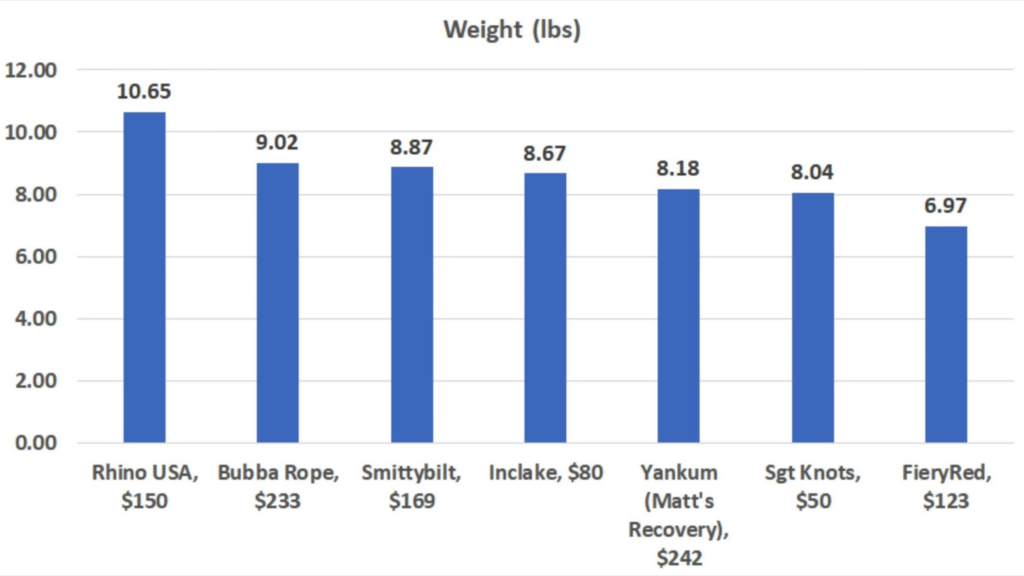
The Rhino USA brand takes center stage within this distinguished lineup with its robust one-inch diameter. It touts a breaking strength of 34,370 pounds and flaunts its ability to store four times the energy of a conventional tow strap. Proudly crafted in China, the Rhino USA rope weighs 10.65 pounds and begins its journey with a length of 30 feet and 8 inches. Another notable contender, the Smittybilt rope, stands on equal footing with a similar one-inch diameter. This rope is meticulously woven from twelve strands, promising superior elasticity and strength. With a breaking strength of 30,000 pounds, the Smittybilt commences its journey at 29 feet and 9 inches, bearing a price tag of $233.
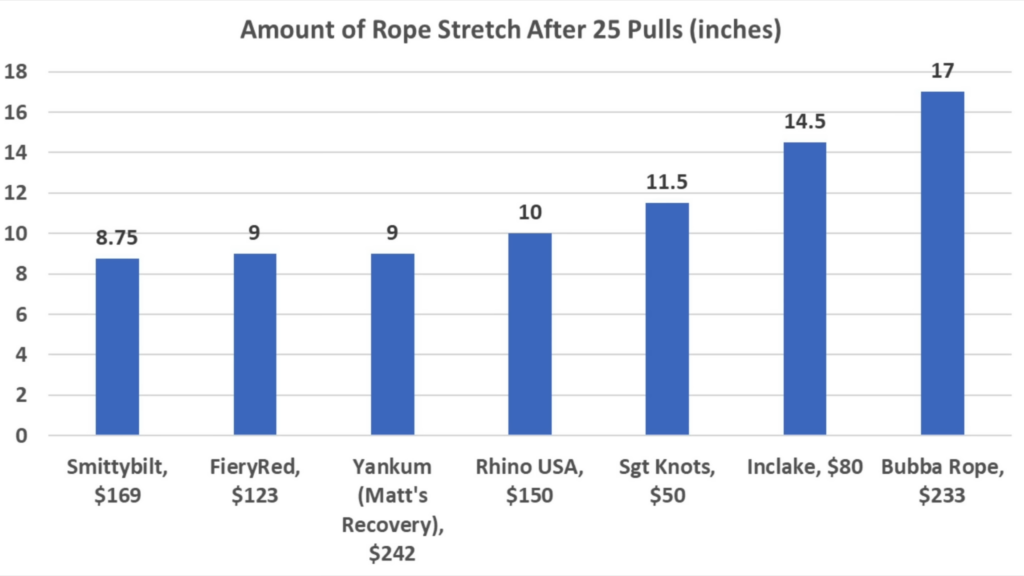
The Bubba Power Stretch Recovery Rope, distinguished by its 7/8 inch diameter, claims an impressive 30-35% stretch capacity. With meticulously spliced eyes adhering to stringent military specifications, this rope proudly hails from the USA and weighs just over nine pounds. Measuring 30 feet and 7 inches, it stands ready to take on challenges, offering its capabilities at $242. Our journey through ropes culminates with the Yankum rope, a beloved choice of Matt’s off-road recovery team. With a similar 7/8 inch diameter, this USA-crafted creation bears a weight of 8.175 pounds and extends 30 feet in length. Its robust construction serves as a testament to its durability and resilience.
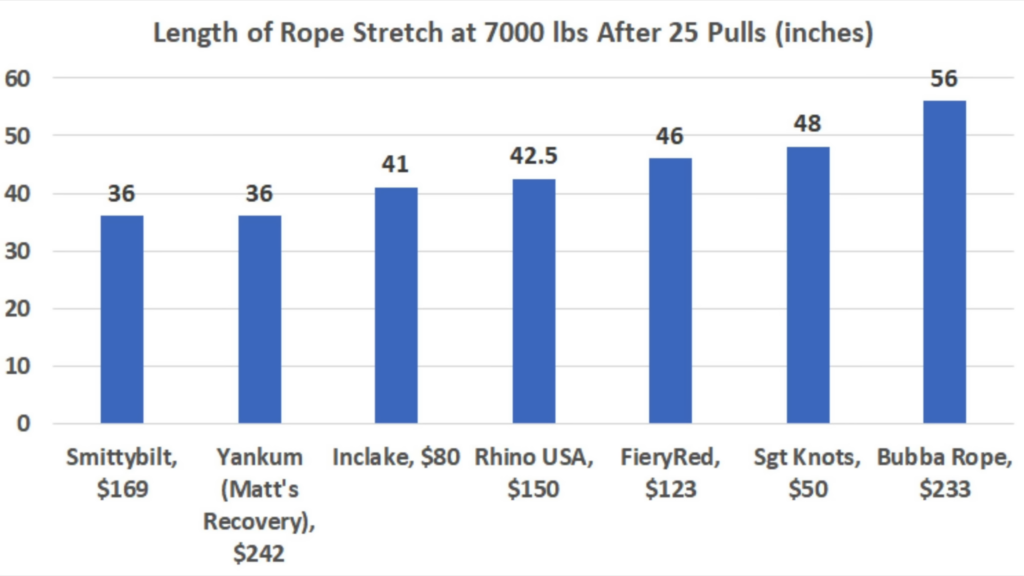
A distinctive characteristic setting kinetic recovery ropes apart from chains or traditional straps is their inherent elasticity. All ropes within this array bear a minimum working load of 7,000 pounds. It is fascinating to note the extent of stretch exhibited by these ropes under a force of 7,000 pounds. The Sergeant Knots rope extends to nearly five feet, boasting a 17% stretch. The Inclake Rope reveals a stretch of 41 inches, translating to a 13-inch loss in elasticity.
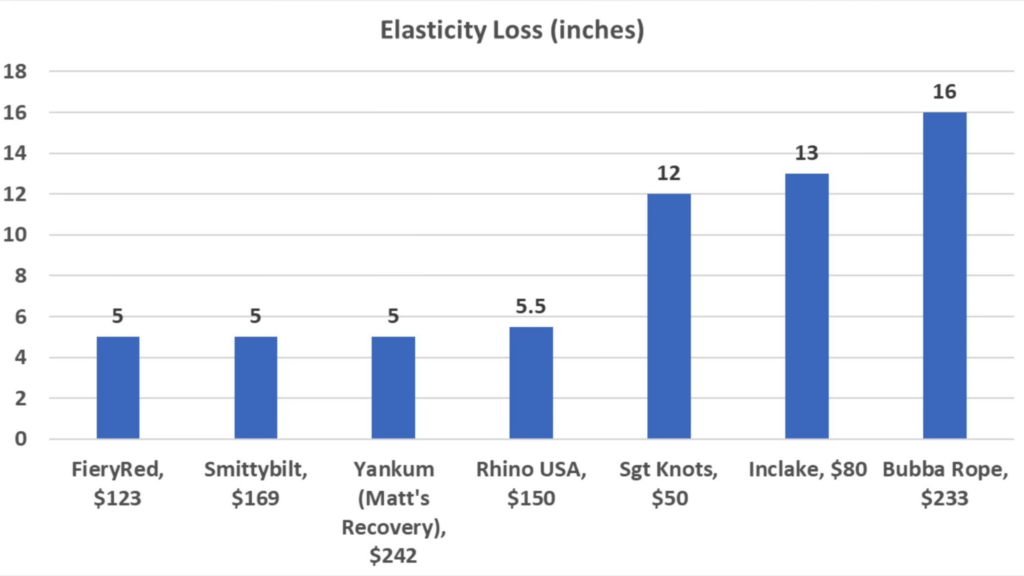
The Fiery Red rope retains 9.8% stretch, concluding at 46 inches. With its 11.5% loss, Rhino USA reaches a stretch of 42.5 inches. Meanwhile, both Smittybilt and Yankum demonstrate a 12.2% decrease, achieving a stretch of 36 inches. The champion in stretchiness, the Bubba Rope, records an impressive 56-inch stretch, resulting in a 20% loss.
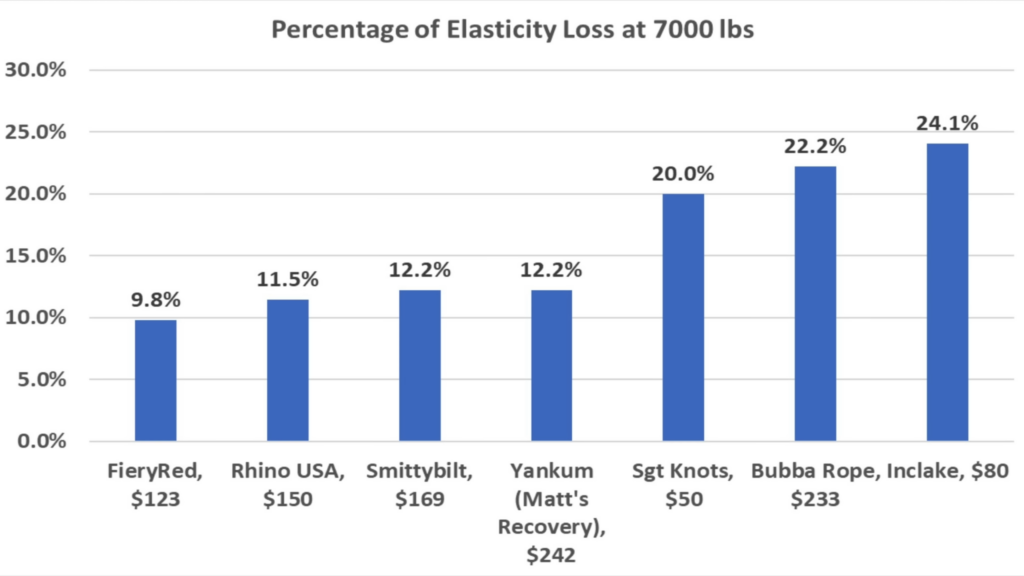
Durability, a key consideration in selecting a suitable recovery rope, is showcased through varying wear and tear. The Sergeant Knots rope remains steadfast and serviceable despite showing signs of wear on its rubberized coating. The Inclake and Fiery Red ropes stand firm, protected by their fabric sleeves. Rhino USA’s fabric sleeve is a testament to its effectiveness in preserving the rope’s integrity. The rubberized coating on the Smittybilt rope emerges as remarkably durable. The Bubba Rope exhibits minimal wear, emphasizing the durability of its rubberized coating. Yankum’s rubberized coating, while displaying signs of use, retains its functionality.
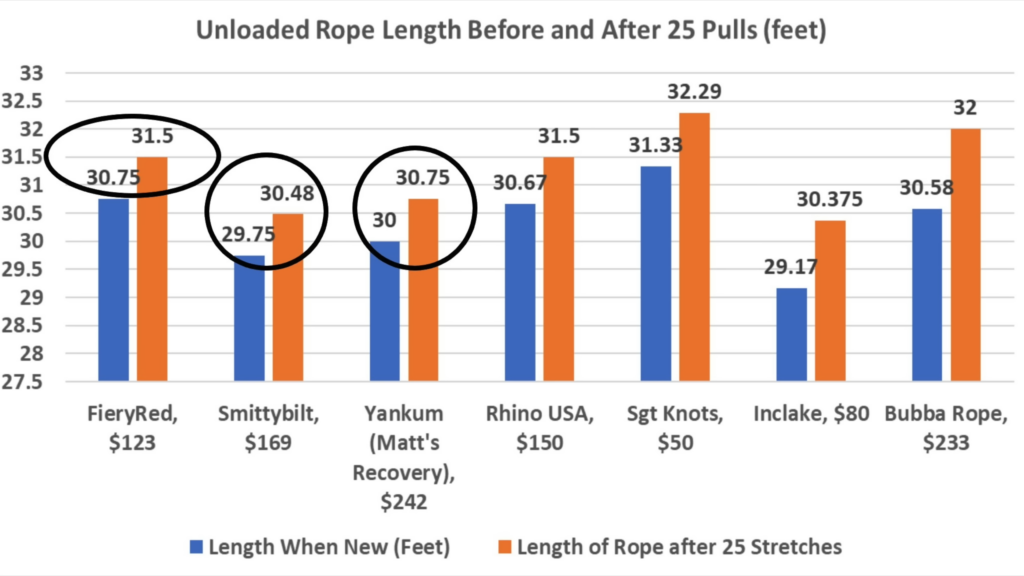
The ultimate test scenario unfolds as the Bubba Rope steps up to free the farmabago from its aquatic entanglement. The Suburban, harnessed by the Bubba Rope’s might, successfully liberates the farmabago, pulling it back onto solid ground. The Bubba Rope emerges as a standout choice, showcasing its impressive gradual winding and unwinding capabilities. Despite its enhanced stretchiness, the Bubba Rope’s durability and exceptional performance in real-life scenarios make it a prime contender.
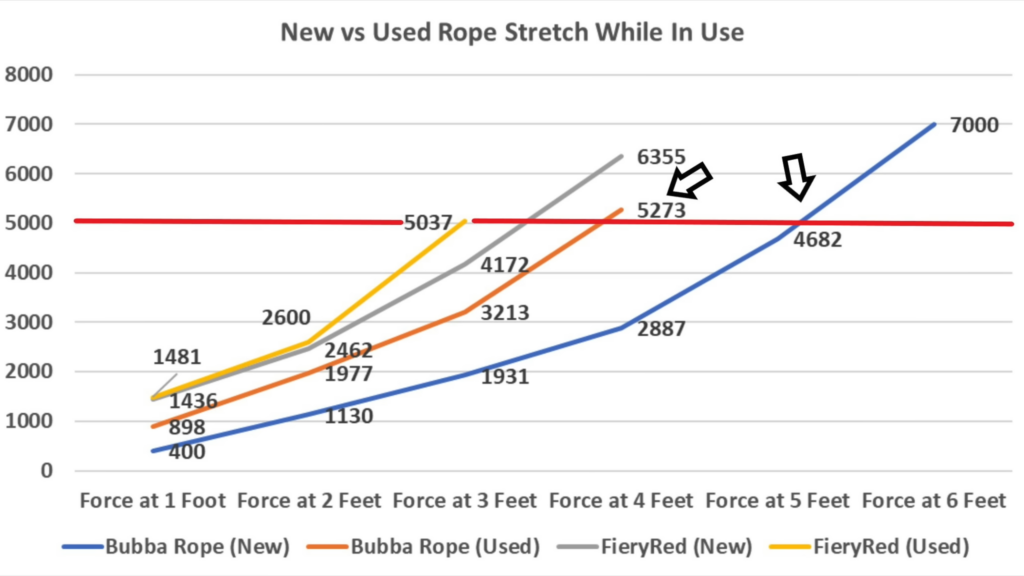
In conclusion, selecting the optimal recovery rope hinges on aligning the rope’s unique strengths with your specific requirements. Should frequent utilization be anticipated, the Fiery Red, Smittybilt, and Yankum ropes offer durability and a more controlled stretch. Despite its enhanced stretch capacity, the Bubba Rope is an excellent choice for those prioritizing a smooth winding and unwinding process. Each rope brings distinctive advantages, necessitating a well-informed choice that harmonizes with your intended applications.
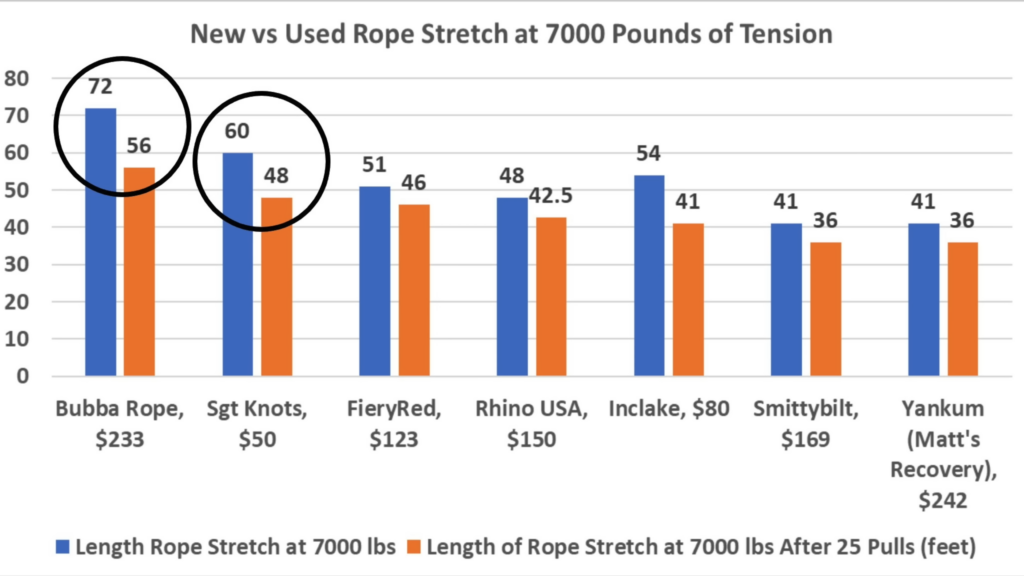
Best Kinetic Recovery Rope: Top 7 Picks
The right equipment is crucial for off-road adventures to ensure a safe and enjoyable experience. A kinetic recovery rope is indispensable for anyone venturing off the beaten path. It’s designed to provide a safer and more efficient way to recover stuck vehicles. We’ve compiled a list of the top 7 kinetic recovery ropes on the market to help you make an informed decision.
1 – Bubba Rope Kinetic Recovery Rope (Best Buy)
Pros:
- High-strength construction for reliable recovery.
- Durable and weather-resistant material.
- Built-in elasticity for a smoother recovery.
Cons: - Limited length options.
- Heavier compared to some alternatives.
Referral Link: Product 1
2 – Yankum Ropes Kinetic Recovery Straps
Pros:
- Innovative design for efficient energy transfer.
- Lightweight yet durable materials.
- Available in various lengths.
Cons: - Higher price point.
- It may require more maintenance.
Referral Link: Product 2
3 – FieryRed Heavy Duty Kinetic Recovery Rope
Pros:
- Double-braided nylon for increased strength.
- UV and weather-resistant construction.
- Comes with a convenient storage bag.
Cons: - Limited elasticity compared to some competitors.
- Slightly thicker, it may require more storage space.
Referral Link: Product 3
4 – INCLAKE Kinetic Recovery Rope
Pros:
- Reflective stitching for increased visibility.
- Reinforced loops for secure attachment.
- Available in different load capacities.
Cons: - Limited length options.
- Slightly more expensive.
Referral Link: Product 4
5 – Rhino USA Kinetic Recovery Rope
Pros:
- Premium-grade materials for enhanced durability.
- Easy to handle and store.
- Suitable for a wide range of vehicles.
Cons: - A relatively new product with limited user reviews.
- Higher cost compared to some alternatives.
Referral Link: Product 5
6 – SGT KNOTS Double Braided Kinetic Recovery Rope
Pros:
- Innovative design for maximum stretch and recovery.
- UV-resistant coating for longevity.
- Lightweight and easy to carry.
Cons: - Limited availability.
- It may not be suitable for extremely heavy-duty applications.
- Referral Link: Product 6
7 – SMITTYBUILT RECOIL Kinetic Recovery Rope
Pros:
- Reliable construction with reinforced loops.
- Compact and easy to store.
- Suitable for various weather conditions.
Cons: - Less elasticity compared to some competitors.
- It may require careful handling to prevent abrasion.
Referral Link: Product 7
1. What is a kinetic recovery rope?
A kinetic recovery rope is a type of towing rope that is designed to help recover stuck vehicles. It is made from a stretchable material, usually nylon, that can store and release kinetic energy. When a vehicle gets stuck, the kinetic recovery rope is attached to both the stuck and recovery vehicles. As the recovery vehicle moves forward, the kinetic energy stored in the rope is released, providing a robust and controlled pull to free the stuck vehicle.
One of the key advantages of a kinetic recovery rope is its ability to absorb and distribute the shock and stress of the recovery process. This helps to minimize the risk of damage to both vehicles and reduces the likelihood of injury to the users. Additionally, the stretchable nature of the rope allows for a smoother and more controlled recovery, as it helps to avoid sudden jolts and jerks.
When choosing a kinetic recovery rope, it is essential to consider factors such as weight rating, length, and diameter. These specifications will determine the suitability of the rope for different types of vehicles and recovery situations. Ensuring the rope is adequately maintained and inspected regularly for its safety and effectiveness is also essential.
2. How do I choose the suitable kinetic recovery rope?
Choosing the suitable kinetic recovery rope depends on several factors, including the weight of your vehicle, the type of terrain you will be driving on, and the specific recovery needs you may have. Here are some key considerations to keep in mind:
- Weight rating: Choose a kinetic recovery rope with a weight rating suitable for your vehicle. The weight rating should be higher than your vehicle’s gross vehicle weight (GVW) to ensure safe and effective recovery.
- Length: Consider the length of the rope based on the recovery scenarios you anticipate. Longer ropes provide more flexibility and can be helpful in situations where the recovery vehicle needs to be positioned further away from the stuck vehicle.
- Diameter: The diameter of the rope can affect its strength and durability. Thicker ropes are generally more robust and durable but may also be heavier and less flexible. Consider the trade-offs and choose a diameter that suits your specific needs.
- Material: Kinetic recovery ropes are typically made from nylon, which offers excellent stretch and strength properties. However, there may be variations in the quality and construction of the nylon material. Look for ropes made from high-quality nylon with reinforced stitching for added durability.
- Accessories: Some kinetic recovery ropes include additional accessories, such as storage bags, shackles, or protective sleeves. These accessories can enhance the convenience and safety of using the rope, so consider whether additional accessories are essential.
Considering these factors and evaluating your needs, you can choose a kinetic recovery rope best suited for your vehicle and recovery requirements.
3. How do I properly use a kinetic recovery rope?
Proper usage of a kinetic recovery rope is essential to ensure safe and effective vehicle recovery. Here are the steps to follow when using a kinetic recovery rope:
- Assess the situation: Before attempting a recovery, assess the situation to ensure it is safe to proceed. Ensure there are no obstacles or hazards in the recovery path and that both vehicles are stable.
- Attach the rope: Attach one end of the kinetic recovery rope to the recovery vehicle’s tow or recovery point. Ensure the attachment is secure and the rope is not twisted or tangled.
- Attach the other end: Attach the other end of the kinetic recovery rope to the stuck vehicle’s tow or recovery point. Again, ensure the attachment is secure and the rope is not twisted or tangled.
- Communicate: Establish clear communication between the drivers of both vehicles. Agree on signals or verbal cues to indicate when to start and stop the recovery process.
- Start the recovery: The recovery vehicle should slowly and steadily move forward, applying gentle tension to the kinetic recovery rope. As the rope stretches and stores kinetic energy, it will pull the stuck vehicle.
- Control the recovery: The driver of the recovery vehicle should maintain a steady and controlled speed, avoiding sudden jerks or stops. The driver of the stuck vehicle should keep the wheels straight and avoid applying any additional throttle.
- Monitor the recovery: Keep a close eye on the recovery process to ensure everything goes smoothly. If any issues or concerns arise, communicate with the other driver and make any necessary adjustments.
- Complete the recovery: Once the stuck vehicle is free, both drivers should come to a controlled stop. Disconnect the kinetic recovery rope from both vehicles, ensuring it is properly stowed and secured.
- Inspect the rope: After the recovery, inspect the kinetic recovery rope for any signs of damage or wear. If any issues are found, replace the rope before using it again.
- Maintain the rope: Regularly clean and inspect the kinetic recovery rope to ensure its continued safety and effectiveness. Store it in a dry and clean location, away from direct sunlight and extreme temperatures.
By following these steps and practicing proper technique, you can safely and effectively use a kinetic recovery rope for vehicle recoveries.
4. Can a kinetic recovery rope damage my vehicle?
When used properly, a kinetic recovery rope should not cause damage to your vehicle. However, following the manufacturer’s instructions and using the rope within its specified weight rating and limitations is essential.
One of the key advantages of a kinetic recovery rope is its ability to absorb and distribute the shock and stress of the recovery process. This helps to minimize the risk of damage to both vehicles involved in the recovery. Additionally, the stretchable nature of the rope allows for a smoother and more controlled recovery, reducing the likelihood of sudden jolts or jerks that could cause damage.
However, exercising caution and using common sense when using a kinetic recovery rope is still essential. Avoid using excessive force or attempting recoveries in situations with a high risk of damage, such as when sharp objects or obstacles are in the recovery path.
Regularly inspect the kinetic recovery rope for any signs of damage or wear, and replace it if any issues are found. Maintaining and using the rope properly can minimize the risk of damage to your vehicle during the recovery process.
5. Can a kinetic recovery rope be used for towing?
While a kinetic recovery rope is primarily designed for vehicle recovery, it can also be used for towing in certain situations. However, it is essential to note that there are limitations and considerations when using a kinetic recovery rope for towing.
Firstly, the weight rating of the kinetic recovery rope should be suitable for the vehicle being towed. The weight of the towed vehicle should not exceed the weight rating of the rope to ensure safe and effective towing.
Secondly, the towing distance should be relatively short and at low speeds. Kinetic recovery ropes are not designed for long-distance or high-speed towing, as the stretchable nature of the rope can affect stability and control.
Additionally, it is essential to ensure that the attachment points on both vehicles are suitable for towing. The tow points should be solid and secure, and the attachment should be done appropriately to avoid accidents or damage.
Before using a kinetic recovery rope for towing, follow the manufacturer’s instructions carefully. If you have any doubts or concerns, it is recommended to consult with a professional or use a dedicated towing rope that is specifically designed for towing purposes.
6. How do I store a kinetic recovery rope?
Proper storage of a kinetic recovery rope is essential to ensure its longevity and effectiveness. Here are some tips for storing a kinetic recovery rope:
- Clean the rope: Before storing the rope, clean it thoroughly to remove any dirt, mud, or debris. Use a mild detergent and warm water to clean the rope, and allow it to dry completely before storing.
- Inspect for damage: Check the rope for any signs of damage or wear, such as fraying, cuts, or abrasions. If any issues are found, repair or replace the rope before storing it.
- Coil the rope: Coil the rope neatly to avoid tangles and knots. Start at one end and work to the other, keeping the coils tight and even.
- Store in a dry and clean location: Store the coiled rope in a dry and clean location, away from direct sunlight and extreme temperatures. Moisture and heat can degrade the rope over time, so choosing a suitable storage area is essential.
- Avoid sharp objects: Keep the stored rope away from sharp objects or edges that could cause damage. Consider using a storage bag or container to provide additional protection.
- Regularly inspect and maintain: Periodically inspect the stored rope for any signs of damage or wear if any issues are found, repair or replace the rope before using it again.
By following these storage tips, you can ensure that your kinetic recovery rope remains in good condition and is ready for use when needed.
7. Can a kinetic recovery rope be used in all weather conditions?
A kinetic recovery rope can be used in various weather conditions, but it is essential to consider each situation’s limitations and precautions.
In general, kinetic recovery ropes are designed to be weather-resistant and can withstand exposure to rain, snow, and mud. The nylon material used in the ropes is resistant to moisture and does not absorb water, which helps to maintain its strength and elasticity even in wet conditions.
However, there are some factors to consider when using a kinetic recovery rope in extreme weather conditions:
- Cold weather: The nylon material may become stiffer and less flexible in frigid temperatures. This can affect the performance of the rope and make it more difficult to stretch and store kinetic energy. It is essential to follow the manufacturer’s recommendations for temperature limitations and consider using a rope specifically designed for cold weather conditions.
- Hot weather: In high temperatures, the nylon material may become softer and more prone to stretching. This can affect the control and stability of the recovery process. It is essential to avoid prolonged exposure to direct sunlight and extreme heat and to regularly inspect the rope for any signs of damage or wear.
- Extreme weather conditions: Attempting vehicle recoveries is generally not recommended in severe weather conditions, such as hurricanes or blizzards. The safety of the users should always be the top priority, and it is essential to wait for the weather conditions to improve before attempting any recoveries.
Before using a kinetic recovery rope in weather conditions, assessing the situation and considering the specific limitations and precautions is essential. If you have any doubts or concerns, it is recommended to consult with a professional or wait for more favorable weather conditions.
8. Can a kinetic recovery rope be used for off-road recoveries?
Yes, a kinetic recovery rope is commonly used for off-road recoveries. The stretchable and shock-absorbing properties of the rope make it well-suited for recovering vehicles stuck in mud, sand, or other off-road terrains.
When using a kinetic recovery rope for off-road recoveries, it is essential to consider the specific challenges and precautions associated with these situations:
- Assess the terrain: Before attempting a recovery, assess the terrain to ensure it is suitable for using a kinetic recovery rope. Avoid recoveries in areas with sharp rocks, steep inclines, or other hazards that could cause damage to the rope or vehicles.
- Choose the suitable rope: Select a kinetic recovery rope suitable for your vehicle’s weight and the specific off-road conditions you will encounter. Consider the rope’s length, diameter, and material to ensure it meets your needs.
- Use proper technique: Follow the proper usage steps outlined earlier in this article to ensure safe and effective off-road recoveries. Communicate with the other driver, maintain control and speed, and monitor the recovery process closely.
- Inspect the rope: After each off-road recovery, inspect the kinetic recovery rope for any signs of damage or wear. Clean and store the rope properly to ensure its longevity and effectiveness.
Following these guidelines and using proper technique, a kinetic recovery rope can be a valuable tool for off-road recoveries, helping to get your vehicle unstuck and back on the trail.
9. Can a kinetic recovery rope tow boats or trailers?
A kinetic recovery rope is not recommended for towing boats or trailers. While the stretchable and shock-absorbing properties of the rope can be beneficial for vehicle recoveries, they may not be suitable for towing heavy loads such as boats or trailers.
When towing boats or trailers, it is essential to use a dedicated towing rope or strap specifically designed for towing purposes. These ropes or straps are typically made from polyester or polypropylene, which offer high strength and durability.
Additionally, towing boats or trailers requires specific techniques and precautions to ensure safe and effective towing. It is essential to follow the manufacturer’s instructions for the towing equipment and to consider factors such as weight distribution, braking, and stability.
If you need to tow a boat or trailer, it is recommended to consult with a professional or use a dedicated towing rope that is suitable for the specific load and towing requirements.
10. Can a kinetic recovery rope be used for recovery on pavement or concrete?
A kinetic recovery rope is not recommended for recovery on pavement or concrete surfaces. The stretchable nature of the rope can cause it to lose traction and control on hard surfaces, increasing the risk of accidents or damage to the vehicles involved.
When recovering vehicles on pavement or concrete, it is essential to use alternative methods or equipment specifically designed for these surfaces. Options such as tow straps, winches, or flatbed tow trucks may be more suitable for recoveries on hard surfaces.
Additionally, it is essential to consider the specific limitations and precautions associated with recoveries on pavement or concrete. Ensure that the recovery equipment and techniques are appropriate and comply with local regulations or restrictions.
Suppose you are unsure about the best method for recovering a vehicle on pavement or concrete. Consulting with a professional or contacting a towing service for assistance is recommended.
Why You Need a Kinetic Recovery Rope
- Safety First: When your vehicle gets stuck in mud, sand, or snow, forcefully tugging it can lead to dangerous situations. A kinetic recovery rope absorbs and distributes the force, reducing the risk of sudden jolts and potential injuries.
- Efficient Recovery: Kinetic ropes utilize their elasticity to provide a smoother and more effective recovery process. This elasticity generates kinetic energy, creating a controlled and gradual pull that can help free your vehicle without damaging it.
- Versatility: Whether you’re a weekend warrior or a serious off-roader, a kinetic recovery rope is a versatile tool that can be used in various scenarios. From rescuing stuck vehicles to assisting others, it’s an essential piece of equipment.
- Durable Construction: The top-notch materials used in these ropes ensure they can withstand the rigors of off-road environments. UV-resistant coatings and reinforced loops enhance their longevity.
- Peace of Mind: Having a reliable kinetic recovery rope in your arsenal gives you the confidence to explore challenging terrains, knowing you have a reliable backup plan in case things don’t go as planned.
Safety should always be a priority when venturing off the beaten path. Choose the kinetic recovery rope best suits your needs and confidently embark on off-road adventures.
(Note: The information provided in this article is based on available data and may be subject to change. Always refer to the product listing and manufacturer’s guidelines for the most accurate and up-to-date information.)
Best Kinetic Recovery Rope FAQs
Summary
| Question | Answer |
|---|---|
| What is a kinetic recovery rope? | A kinetic recovery rope is a stretchable towing rope to recover stuck vehicles. |
| How do I choose the suitable kinetic recovery rope? | A kinetic recovery rope is a stretchable towing rope to recover stuck vehicles. |
| How do I properly use a kinetic recovery rope? | Follow steps like assessing the situation, attaching the rope, and maintaining control during recovery. |
| Can a kinetic recovery rope damage my vehicle? | When used properly, a kinetic recovery rope should not cause damage to your vehicle. |
| Can a kinetic recovery rope be used for towing? | A kinetic recovery rope can be used for towing in certain situations, but there are limitations to consider. |
| How do I store a kinetic recovery rope? | Clean the rope, inspect for damage, coil it neatly, and store it in a dry and clean location. |
| Can a kinetic recovery rope be used in all weather conditions? | A kinetic recovery rope can be used in various weather conditions, but extreme temperatures may affect its performance. |
FAQs
1. What is the weight rating of a kinetic recovery rope?
The weight rating of a kinetic recovery rope varies depending on the specific product. Choosing a rope with a weight rating higher than your vehicle’s gross vehicle weight (GVW) is essential to ensure safe and effective recovery.
2. Can I use a kinetic recovery rope for towing a trailer?
A kinetic recovery rope is not recommended for towing trailers. It is designed for vehicle recovery and may not have the strength and stability to tow heavy loads. A dedicated towing rope or strap designed explicitly for trailers is best.
3. How often should I inspect my kinetic recovery rope for damage?
Inspecting your kinetic recovery rope before each use and regularly during storage is recommended. Look for signs of fraying, cuts, abrasions, or any other damage that may compromise the rope’s integrity. If any damage is found, replace the rope immediately.
4. Can I use a kinetic recovery rope for recovering a vehicle on the pavement?
No, a kinetic recovery rope is unsuitable for recovering a vehicle on pavement or concrete surfaces. The stretchable nature of the rope can cause it to lose traction and control on hard surfaces, increasing the risk of accidents or damage to the vehicles involved. Alternative methods or equipment designed explicitly for hard surface recovery is best.
5. Can I use a kinetic recovery rope to recover a water vehicle?
No, a kinetic recovery rope should not be used for recovering a vehicle in water. Water can affect the rope’s performance and safety, and additional risks may be associated with recoveries in water. It is best to use specialized equipment and techniques for water recovery.
6. Can I use a kinetic recovery rope for recovering a vehicle on a steep incline?
Recovering a vehicle on a steep incline can be challenging and potentially dangerous. It is not recommended to use a kinetic recovery rope in such situations, as the stretchable nature of the rope may not provide the necessary control and stability. It is best to consult a professional or use alternative recovery methods for steep-incline situations.
7. Can I use a kinetic recovery rope for recovering a vehicle in extreme weather conditions?
Extreme weather conditions, such as hurricanes or blizzards, can pose additional risks and challenges for vehicle recovery. It is generally not recommended to attempt recoveries in such conditions. The safety of the users should always be the top priority, and it is essential to wait for the weather conditions to improve before attempting any recoveries.









Leave a Reply